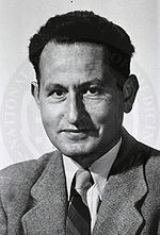
Heinz Fraenkel-Conrat
Encyclopedia
Heinz Ludwig Fraenkel-Conrat (July 29, 1910 – April 10, 1999) was a biochemist
, famous for his viral research.
Fraenkel-Conrat was born in Breslau/Germany
and received an MD from the University of Breslau in 1933. Due to the rise of Nazism
in Germany he left for Scotland
in 1933 and finished his PhD at the University of Edinburgh
(1936). After completing his doctorate, he emigrated to the United States
, becoming a naturalized citizen in 1941. He worked at a number of institutes before joining the faculty at the University of California, Berkeley
in 1952 where he remained until his death.
His most noted research was on the tobacco mosaic virus
. He discovered that the genetic control of viral reproduction was RNA
and that it is carried in the nucleic core of each virus. In 1955 he and biophysicist Robley Williams showed that a functional virus could be created out of purified RNA and a protein
coat. In 1960 he announced the complete sequencing of the 158 amino acid
s in the virus.
Biochemistry
Biochemistry, sometimes called biological chemistry, is the study of chemical processes in living organisms, including, but not limited to, living matter. Biochemistry governs all living organisms and living processes...
, famous for his viral research.
Fraenkel-Conrat was born in Breslau/Germany
Germany
Germany , officially the Federal Republic of Germany , is a federal parliamentary republic in Europe. The country consists of 16 states while the capital and largest city is Berlin. Germany covers an area of 357,021 km2 and has a largely temperate seasonal climate...
and received an MD from the University of Breslau in 1933. Due to the rise of Nazism
Nazism
Nazism, the common short form name of National Socialism was the ideology and practice of the Nazi Party and of Nazi Germany...
in Germany he left for Scotland
Scotland
Scotland is a country that is part of the United Kingdom. Occupying the northern third of the island of Great Britain, it shares a border with England to the south and is bounded by the North Sea to the east, the Atlantic Ocean to the north and west, and the North Channel and Irish Sea to the...
in 1933 and finished his PhD at the University of Edinburgh
University of Edinburgh
The University of Edinburgh, founded in 1583, is a public research university located in Edinburgh, the capital of Scotland, and a UNESCO World Heritage Site. The university is deeply embedded in the fabric of the city, with many of the buildings in the historic Old Town belonging to the university...
(1936). After completing his doctorate, he emigrated to the United States
United States
The United States of America is a federal constitutional republic comprising fifty states and a federal district...
, becoming a naturalized citizen in 1941. He worked at a number of institutes before joining the faculty at the University of California, Berkeley
University of California, Berkeley
The University of California, Berkeley , is a teaching and research university established in 1868 and located in Berkeley, California, USA...
in 1952 where he remained until his death.
His most noted research was on the tobacco mosaic virus
Tobacco mosaic virus
Tobacco mosaic virus is a positive-sense single stranded RNA virus that infects plants, especially tobacco and other members of the family Solanaceae. The infection causes characteristic patterns on the leaves . TMV was the first virus to be discovered...
. He discovered that the genetic control of viral reproduction was RNA
RNA
Ribonucleic acid , or RNA, is one of the three major macromolecules that are essential for all known forms of life....
and that it is carried in the nucleic core of each virus. In 1955 he and biophysicist Robley Williams showed that a functional virus could be created out of purified RNA and a protein
Protein
Proteins are biochemical compounds consisting of one or more polypeptides typically folded into a globular or fibrous form, facilitating a biological function. A polypeptide is a single linear polymer chain of amino acids bonded together by peptide bonds between the carboxyl and amino groups of...
coat. In 1960 he announced the complete sequencing of the 158 amino acid
Amino acid
Amino acids are molecules containing an amine group, a carboxylic acid group and a side-chain that varies between different amino acids. The key elements of an amino acid are carbon, hydrogen, oxygen, and nitrogen...
s in the virus.

